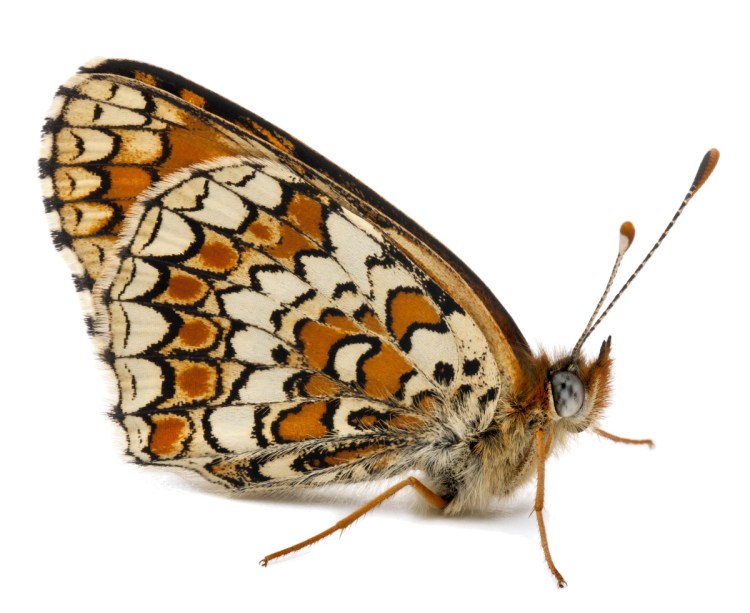Butterflies should have a place in every garden. They are colorful, not unlike flowers that have lost their anchoring roots, flitting from plant to plant. And they are quiet, meaning they don’t disturb sleep like some early-morning wild things do.
During a presentation at the Maine Flower Show in March, Andy Brand, hired earlier this year as plant curator at Coastal Maine Botanical Gardens, offered tips on how to attract butterflies to a garden.
He emphasized that you have to do more than provide a home for the eye-catching butterflies. You also have to provide habitat for the earlier stage – caterpillars, which are often beautiful in their own right.
I’ll get to the plants needed to attract butterflies in a moment, but at least one of the non-plant items surprised me. Butterflies have to do something called puddling, which, as the name implies, means spending time in puddles, preferably puddles that have damp sand.
“Butterflies get nutrition, salts and other things out of damp sand that they need for reproduction and to be healthy,” Brand said.
Now, thanks to Brand, I don’t feel so bad that puddles form in our driveway, which is made of used bricks with a bit of sand between them. Maybe I’ll move some of that driveway sand to just inside of our bird bath in the backyard, as well. Plus, Brand gave me yet another reason to hate asphalt driveways.
In addition to damp sand, butterflies need a source of water. They need spaces for shelter, to protect them from the wind. And they need plenty of sunshine, so they can bask in the warmth.
Now, to the plants.
If this sounds familiar to regular readers, forgive me, but given the perilous state of many butterfly species, it’s worth repeating.
To attract butterflies, a garden needs plant diversity – many different kinds of plants, and mostly natives. Native butterflies and native plants evolved together, and they naturally help each other. The plants provide food to the butterflies; the butterflies pollinate the plants.
You need many different plants in part because Maine is home to many different butterflies – 118 different species, Brand said, of which 20 are in varying levels of danger. Although those 118 species will often eat and otherwise use the same plants, they are on different schedules, so you need plants that provide food – pollen, nectar and sap – throughout the season.
Brand gave the mourning cloak butterfly as one example. It’s a dark butterfly native to the United States and Canada that overwinters as an adult, nestled in tree bark and log piles. Like many other creatures, it’s hungry when spring finally arrives, so it gorges on sap from broken maple branches. It likes pussy willow pollen, too.
Highbush blueberries are an important source of nectar for butterflies that emerge early – so I’m glad that I planted 13 of them over the past two years. Clover allowed to grow and blossom in a meadow (or in your lawn, for that matter; ordinary lawns are a poor source of habitat because they are usually monocultures) is an excellent source of nectar throughout the summer for many different butterflies.
The relationship of monarch butterflies and milkweed is well known, and the population of monarchs is shrinking. (Their numbers have declined more than 80 percent over the past two decades, according to the Arizona-based nonprofit the Center for Biological Diversity.) But other butterflies also feed on the three varieties of asclepias that feed monarchs, Brand said.
While common milkweed, Asclepias syriaca, will spread, it can be controlled. Swamp milkweed, asclepias incarnata, does well in wet soil, but also will survive in a typical Maine garden. Asclepias tuberosa also thrives in Maine gardens. Brand showed a photo of a coral hairstreak butterfly on Asclepias tuberosa – both blossom and butterfly were the same arresting orange color.
Late-season butterflies need late-blooming flowers. On a sunny day in the botanical gardens, Anise hyssop, or Agastache foeniculum, will be carpeted with butterflies, Brand said. Although anise is a short-lived perennial, it will self-seed and has lasted well in our Cape Elizabeth garden for many years.
Other late-blooming plants that butterflies love include goldenrod, Joe Pye weed and asters.
Part of the reason I enjoyed Brand’s talk is that we seem to have a lot in common. He said he has a lot of violets in his lawn, as do I. The fritillary butterfly lays its eggs on violets and depends on them for food. Brand mows his lawn high so as not to damage the violets.
Finally, an excuse to mow the lawn as infrequently as possible.
ABOUT THE WRITER
TOM ATWELL is a freelance writer gardening in Cape Elizabeth. He can be contacted at: tomatwell@me.com.
Send questions/comments to the editors.



